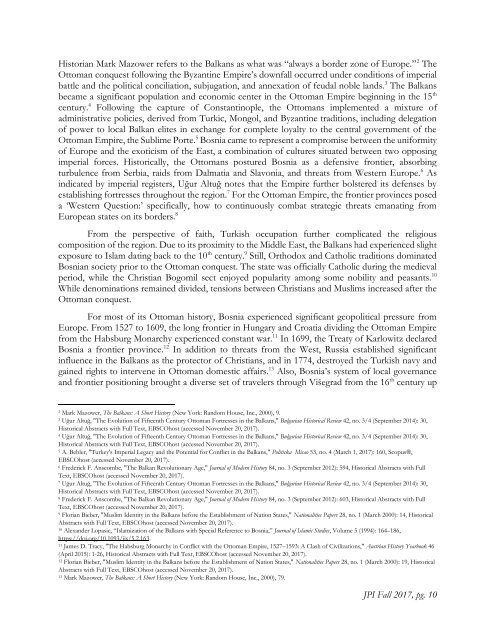JPI Spring 2018
Create successful ePaper yourself
Turn your PDF publications into a flip-book with our unique Google optimized e-Paper software.
Historian Mark Mazower refers to the Balkans as what was “always a border zone of Europe.” 2 The<br />
Ottoman conquest following the Byzantine Empire’s downfall occurred under conditions of imperial<br />
battle and the political conciliation, subjugation, and annexation of feudal noble lands. 3 The Balkans<br />
became a significant population and economic center in the Ottoman Empire beginning in the 15 th<br />
century. 4 Following the capture of Constantinople, the Ottomans implemented a mixture of<br />
administrative policies, derived from Turkic, Mongol, and Byzantine traditions, including delegation<br />
of power to local Balkan elites in exchange for complete loyalty to the central government of the<br />
Ottoman Empire, the Sublime Porte. 5 Bosnia came to represent a compromise between the uniformity<br />
of Europe and the exoticism of the East, a combination of cultures situated between two opposing<br />
imperial forces. Historically, the Ottomans postured Bosnia as a defensive frontier, absorbing<br />
turbulence from Serbia, raids from Dalmatia and Slavonia, and threats from Western Europe. 6 As<br />
indicated by imperial registers, Uğur Altuğ notes that the Empire further bolstered its defenses by<br />
establishing fortresses throughout the region. 7 For the Ottoman Empire, the frontier provinces posed<br />
a ‘Western Question:’ specifically, how to continuously combat strategic threats emanating from<br />
European states on its borders. 8<br />
From the perspective of faith, Turkish occupation further complicated the religious<br />
composition of the region. Due to its proximity to the Middle East, the Balkans had experienced slight<br />
exposure to Islam dating back to the 10 th century. 9 Still, Orthodox and Catholic traditions dominated<br />
Bosnian society prior to the Ottoman conquest. The state was officially Catholic during the medieval<br />
period, while the Christian Bogomil sect enjoyed popularity among some nobility and peasants. 10<br />
While denominations remained divided, tensions between Christians and Muslims increased after the<br />
Ottoman conquest.<br />
For most of its Ottoman history, Bosnia experienced significant geopolitical pressure from<br />
Europe. From 1527 to 1609, the long frontier in Hungary and Croatia dividing the Ottoman Empire<br />
from the Habsburg Monarchy experienced constant war. 11 In 1699, the Treaty of Karlowitz declared<br />
Bosnia a frontier province. 12 In addition to threats from the West, Russia established significant<br />
influence in the Balkans as the protector of Christians, and in 1774, destroyed the Turkish navy and<br />
gained rights to intervene in Ottoman domestic affairs. 13 Also, Bosnia’s system of local governance<br />
and frontier positioning brought a diverse set of travelers through Višegrad from the 16 th century up<br />
2<br />
Mark Mazower, The Balkans: A Short History (New York: Random House, Inc., 2000), 9.<br />
3<br />
Uğur Altuğ, "The Evolution of Fifteenth Century Ottoman Fortresses in the Balkans," Bulgarian Historical Review 42, no. 3/4 (September 2014): 30,<br />
Historical Abstracts with Full Text, EBSCOhost (accessed November 20, 2017).<br />
4<br />
Uğur Altuğ, "The Evolution of Fifteenth Century Ottoman Fortresses in the Balkans," Bulgarian Historical Review 42, no. 3/4 (September 2014): 30,<br />
Historical Abstracts with Full Text, EBSCOhost (accessed November 20, 2017).<br />
5<br />
A. Bebler, "Turkey's Imperial Legacy and the Potential for Conflict in the Balkans," Politicka Misao 53, no. 4 (March 1, 2017): 160, Scopus®,<br />
EBSCOhost (accessed November 20, 2017).<br />
6<br />
Frederick F. Anscombe, "The Balkan Revolutionary Age," Journal of Modern History 84, no. 3 (September 2012): 594, Historical Abstracts with Full<br />
Text, EBSCOhost (accessed November 20, 2017).<br />
7<br />
Uğur Altuğ, "The Evolution of Fifteenth Century Ottoman Fortresses in the Balkans," Bulgarian Historical Review 42, no. 3/4 (September 2014): 30,<br />
Historical Abstracts with Full Text, EBSCOhost (accessed November 20, 2017).<br />
8<br />
Frederick F. Anscombe, "The Balkan Revolutionary Age," Journal of Modern History 84, no. 3 (September 2012): 603, Historical Abstracts with Full<br />
Text, EBSCOhost (accessed November 20, 2017).<br />
9<br />
Florian Bieber, "Muslim Identity in the Balkans before the Establishment of Nation States," Nationalities Papers 28, no. 1 (March 2000): 14, Historical<br />
Abstracts with Full Text, EBSCOhost (accessed November 20, 2017).<br />
10<br />
Alexander Lopasic, “Islamization of the Balkans with Special Reference to Bosnia,” Journal of Islamic Studies, Volume 5 (1994): 164–186,<br />
https://doi.org/10.1093/jis/5.2.163.<br />
11<br />
James D. Tracy, "The Habsburg Monarchy in Conflict with the Ottoman Empire, 1527–1593: A Clash of Civilizations," Austrian History Yearbook 46<br />
(April 2015): 1-26, Historical Abstracts with Full Text, EBSCOhost (accessed November 20, 2017).<br />
12<br />
Florian Bieber, "Muslim Identity in the Balkans before the Establishment of Nation States," Nationalities Papers 28, no. 1 (March 2000): 19, Historical<br />
Abstracts with Full Text, EBSCOhost (accessed November 20, 2017).<br />
13<br />
Mark Mazower, The Balkans: A Short History (New York: Random House, Inc., 2000), 79.<br />
<strong>JPI</strong> Fall 2017, pg. 10
















